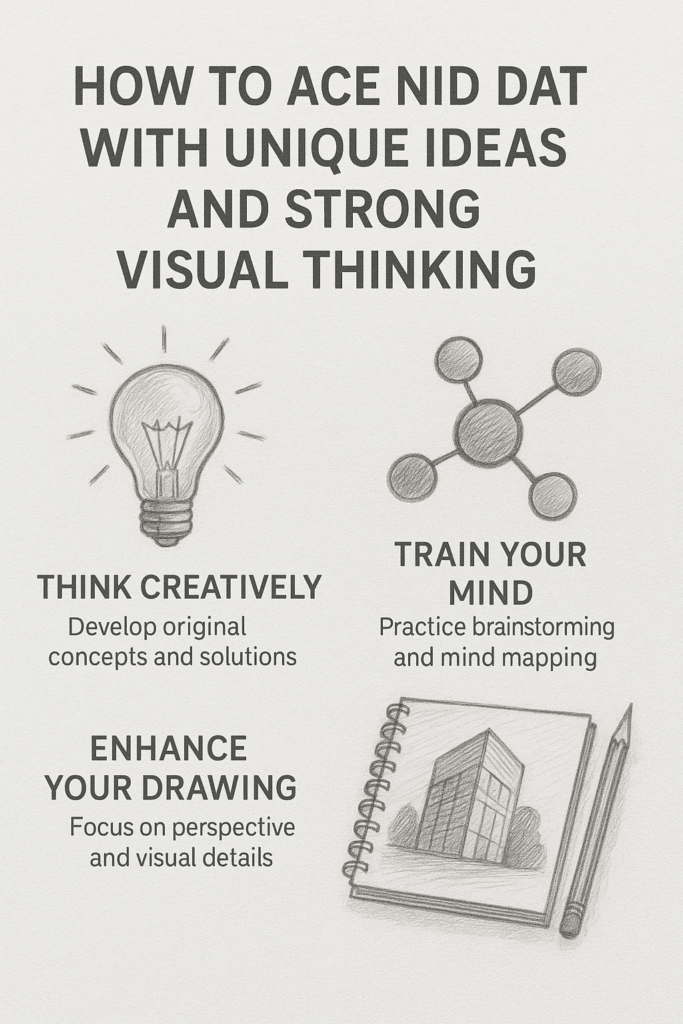
Design is more than aesthetics—it’s about thinking differently. When it comes to acing the NID DAT (Design Aptitude Test), your ability to generate unique ideas and demonstrate strong visual thinking is what sets you apart from thousands of other candidates. Here’s how to train your creative muscles and develop a design-thinking approach to crack the exam confidently.
1. 💡 Think Creatively: Beyond the Obvious
Creative thinking is all about approaching problems with fresh perspectives. The DAT often includes questions where you need to imagine, innovate, and express originality.
🔸 Techniques to Develop Creative Thinking:
- SCAMPER Technique (Substitute, Combine, Adapt, Modify, Put to another use, Eliminate, Rearrange)
- Visual Analogy: Think metaphorically (e.g., what if a chair looked like a bird?)
- Alternate Uses Game: How many uses can you list for a paperclip? A brick?
Tip: Push your imagination. Think wacky, wild, even poetic—it shows bold thinking.
2. 🧠 Train Your Mind: Practice Brainstorming & Mind Mapping
A strong visual thinker can connect ideas quickly and see patterns others miss. Mind mapping is one of the best ways to enhance lateral thinking.
🔸 Activities to Sharpen Mental Flexibility:
- Mind Maps: Take a word like “Rain” and expand it to 20 connected ideas.
- Daily Doodles: Sketch 3 random prompts (like “balloon,” “bridge,” “sadness”) and combine them in one story or scene.
- 30 Circles Exercise: Fill 30 circles with unique drawings in 2 minutes. It’s harder than it sounds—and brilliant for idea generation.
3. ✍️ Enhance Your Drawing: Communicate Visually
Your drawing doesn’t need to be photorealistic—but it must be clear, quick, and communicative. Your sketches are your voice in the exam. They tell the jury how well you think and solve problems.
🔸 Drawing Skills to Build:
- Perspective and Depth: Learn one-point and two-point perspectives.
- Line Clarity: Clean lines > over-shading. Be confident and intentional.
- Figures and Gestures: Basic human proportions, emotions, actions.
- Object Sketching: Practice sketching everyday objects in multiple views.
Tip: Work with graphite pencils, gel pens, and dry pastels to get comfortable with exam tools.
4. 🎨 Use Visual Storytelling: Show, Don’t Just Tell
The NID DAT often asks you to illustrate a scenario or tell a story visually. Your job is to direct the viewer’s eye and emotions.
🔸 Ways to Practice:
- Storyboard Panels: Create a 3-frame or 6-frame comic strip for a daily event.
- Scene Building: Pick a prompt (like “Lost in the city”) and sketch a scene with background, characters, mood, and action.
- Before & After Sketches: Visually show change or transition.
5. 💭 Observe, Reflect, Redesign
Great design is born from observation. Whether it’s the way a teabag works or how a street vendor arranges their cart, notice details.
🔸 Observation Exercises:
- Redesign Tasks: Pick an everyday object and sketch 3 better versions of it.
- Visual Journaling: Carry a sketchbook and note/sketch 2-3 things daily.
- Problem-Solution Diagrams: Observe a problem in public spaces and illustrate a solution.
🎯 Final Tips:
- Practice under time constraints.
- Don’t aim for perfection—aim for clarity and originality.
- Focus on expressing an idea rather than making your drawing pretty.
- Show process and thought, not just final results.
🌟 In Summary:
Cracking the NID DAT is about thinking like a designer—questioning the norm, dreaming bold, and expressing those dreams visually. With consistent practice and a mindset to experiment, you’re already halfway there.
Want to succeed your pursuit of a dream career.? Join our effective training course for NID Entrance Test. Call / WhatsApp: +91 9902739994
